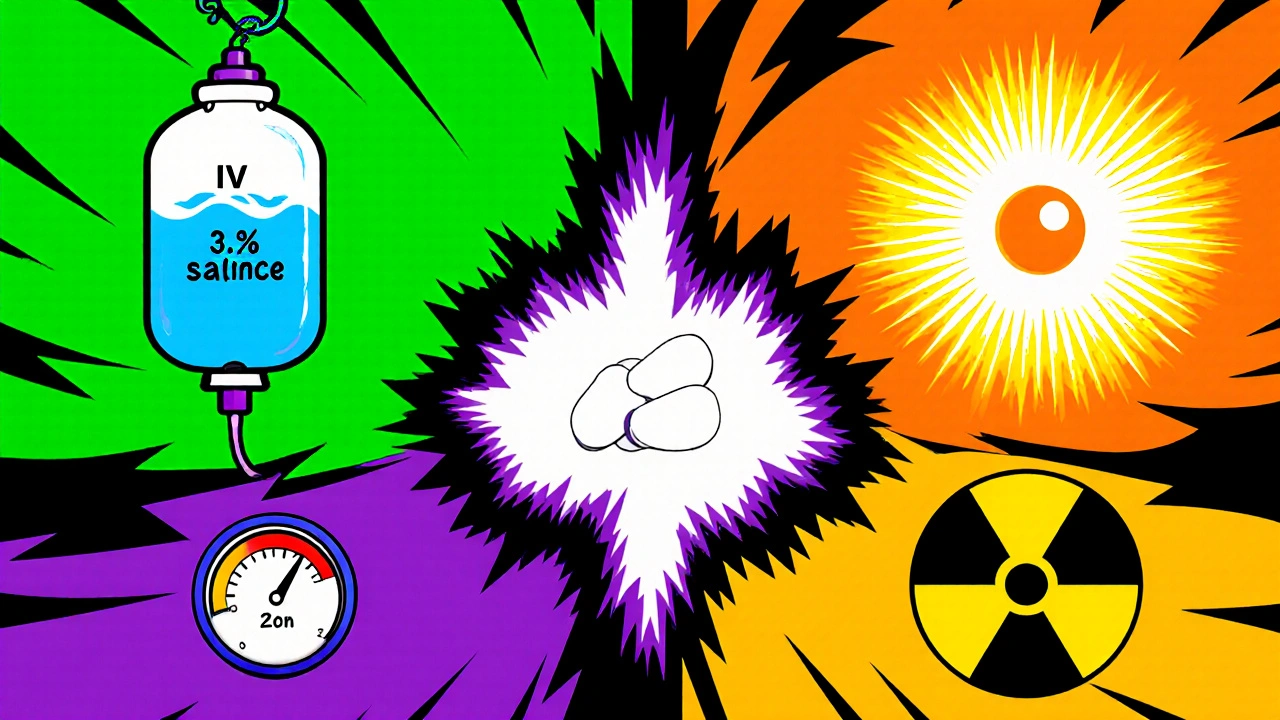Hyponatremia and Thyroid Disorders: How They Influence Each Other
 Oct, 20 2025
Oct, 20 2025
When you hear the words hyponatremia and thyroid, you might think they belong to completely different medical worlds. In practice, they often intersect, and the connection can be the key to solving a puzzling case. Below we untangle the physiology, look at real‑world scenarios, and give you a clear roadmap for diagnosis and treatment.
What Is Hyponatremia?
Hyponatremia is a condition where the concentration of sodium in the blood falls below 135 mmol/L. Sodium is the main extracellular electrolyte, and its balance drives water movement between cells and the bloodstream. When sodium drops, water shifts into cells, leading to swelling that can affect the brain, muscles, and virtually every organ system. Common triggers include excessive fluid intake, diuretic use, heart failure, kidney disease, and hormonal disturbances such as inappropriate antidiuretic hormone secretion (SIADH).
Thyroid Disorders at a Glance
Thyroid disorders encompass any condition that alters the production or action of thyroid hormones-primarily thyroxine (T4) and triiodothyronine (T3). The most prevalent forms are hypothyroidism (under‑active thyroid) and hyperthyroidism (over‑active thyroid). Both extremes ripple through metabolism, cardiovascular function, and fluid balance, setting the stage for electrolyte quirks.
Why Thyroid Hormones Touch Sodium Balance
Thyroid hormones influence sodium in three main ways:
- Renal hemodynamics: T3 and T4 increase renal blood flow and glomerular filtration rate, which alters how the kidneys handle water and sodium.
- Antidiuretic hormone (ADH) regulation: Low thyroid states can boost ADH release, promoting water reabsorption and diluting serum sodium.
- Cardiac output: Hyperthyroidism raises heart rate and stroke volume, often leading to a high‑output state that can trigger compensatory mechanisms affecting sodium.
Understanding these pathways explains why a patient with a thyroid problem might present with low sodium, even if they’ve never taken a diuretic.
Clinical Scenarios Where Hyponatremia Meets Thyroid Issues
Below are three common patterns you might see in a clinic or hospital:
- Hypothyroidism‑related hyponatremia: Severe, untreated hypothyroidism can cause a mild to moderate drop in sodium (often 130‑135 mmol/L). The mechanism is primarily increased ADH secretion combined with reduced cardiac output, which triggers baroreceptor‑mediated water retention.
- Hyperthyroidism‑induced SIADH: Graves’ disease or toxic nodular goitre can produce a high‑output state that stimulates pulmonary stretch receptors, leading to inappropriate ADH release and subsequent dilutional hyponatremia.
- Thyroid‑medication side effects: Levothyroxine (synthetic T4) can, in rare cases, cause rapid shifts in metabolism that overshoot water handling, especially when dosed aggressively after a period of low thyroid function.
Each scenario demands a tailored work‑up, but the underlying principle is the same: look for hormonal clues when sodium levels don’t match the obvious causes.
Diagnosing the Overlap - A Step‑by‑Step Checklist
- Confirm true hyponatremia: Measure serum sodium twice, correct for lipemia or hyperglycaemia, and assess serum osmolality (<280 mOsm/kg indicates hypotonic hyponatremia).
- Determine volume status: Clinical exam (dry mucosa, edema, orthostatic changes) plus bedside ultrasound can classify patients as hypovolaemic, euvolemic, or hypervolemic.
- Screen thyroid function: Order TSH, free T4, and if needed, free T3. In hypothyroidism you’ll see high TSH with low free T4; hyperthyroidism shows suppressed TSH and elevated free T4/T3.
- Check ADH activity: While direct ADH levels are rarely measured, a high urine osmolality (>100 mOsm/kg) with euvolemia points toward SIADH.
- Rule out other endocrine culprits: Cortisol deficiency (add a morning cortisol), and adrenal insufficiency can coexist with thyroid disease and cause hyponatremia.
- Identify medication contributors: Diuretics, selective serotonin reuptake inhibitors (SSRIs), and carbamazepine are common offenders.
Following this algorithm not only catches the thyroid link but also prevents missing a more urgent cause like adrenal crisis.

Management Strategies Tailored to the Thyroid‑Sodium Interaction
Therapy splits into two tracks: correcting sodium and addressing the thyroid abnormality.
Correcting Sodium
- Mild hyponatremia (130‑134 mmol/L) and no severe symptoms: Fluid restriction (800‑1000 ml/day) is often enough, especially if ADH is the driver.
- Severe hyponatremia (<125 mmol/L) or neurologic signs: Use hypertonic (3%) saline cautiously-raise sodium no more than 8 mmol/L in the first 24 hours to avoid osmotic demyelination.
- SIADH‑type cases linked to hyperthyroidism: Consider loop diuretics or vasopressin antagonists (e.g., tolvaptan) if fluid restriction fails.
Thyroid‑Specific Treatment
- Hypothyroidism: Start low‑dose levothyroxine (25‑50 µg) and titrate every 4‑6 weeks. Sodium usually normalises as ADH levels drop and cardiac output improves.
- Hyperthyroidism: Antithyroid drugs (methimazole) or radioactive iodine therapy reduces metabolic rate, which in turn eases ADH‑mediated water retention.
- Rapid correction caution: Avoid over‑correcting thyroid hormone too quickly; abrupt shifts can worsen electrolyte derangements.
In practice, you’ll often treat both arms simultaneously. For example, a patient with newly diagnosed Graves’ disease and a sodium of 128 mmol/L may receive a short course of fluid restriction plus methimazole, then reassess sodium in 48 hours.
Key Takeaways Checklist
- Always measure thyroid function when you encounter unexplained hyponatremia, especially in euvolemic patients.
- Recognise that severe hypothyroidism can mimic SIADH by raising ADH levels.
- Fluid restriction is first‑line for mild cases; reserve hypertonic saline for neurologic emergencies.
- Address the thyroid disorder early - correcting TSH and free T4 often resolves the sodium problem.
- Monitor sodium every 6‑12 hours during rapid interventions to stay within safe correction limits.
Frequently Asked Questions
Can mild hypothyroidism cause hyponatremia?
Yes. Even subclinical hypothyroidism can increase ADH secretion enough to lower sodium by a few points, especially if the patient is also on a thiazide diuretic.
Is fluid restriction effective for hyperthyroid‑related SIADH?
It helps, but many patients need an additional agent such as a vasopressin antagonist or a loop diuretic because the ADH drive is strong.
Should levothyroxine be started immediately in a hyponatremic patient?
Start at a low dose and increase gradually. Rapid dosing can cause a sudden shift in water balance, worsening hyponatremia.
What lab values confirm SIADH in the context of thyroid disease?
Low serum osmolality (<275 mOsm/kg), inappropriately high urine osmolality (>100 mOsm/kg), urine sodium >30 mmol/L, and euvolemic clinical exam, plus normal adrenal and renal function tests.
Can treating hyperthyroidism alone normalize sodium levels?
Often, yes. As thyroid hormone levels fall, the abnormal ADH stimulus wanes, allowing the kidneys to excrete excess water and restore normal sodium.
By keeping an eye on both electrolytes and thyroid labs, you’ll catch the hidden link before it turns into a life‑threatening situation.
Ron Lanham
October 20, 2025 AT 14:42When you see a patient with unexplained hyponatremia, the first thing you should do is ask yourself whether you have overlooked the endocrine axis, because ignoring thyroid function is a negligent habit that many clinicians proudly uphold as if it were a minor detail. The pathophysiology is not a mystery: low thyroid states ramp up antidiuretic hormone, the kidneys retain water, and sodium gets diluted, a cascade that any competent physician should recognize without a second thought. Yet, far too often, the medical community treats hyponatremia as a purely renal or cardiac problem, refusing to acknowledge that thyroid hormones are the conductors of the whole orchestra of fluid balance. This blind spot is not just a gap in knowledge; it is a moral failing, an abdication of the duty to look at the patient holistically and treat them with the respect they deserve. We must demand that residency programs include endocrine cross‑talk in their hyponatremia modules, that attending physicians model comprehensive review of thyroid panels, and that guidelines explicitly list thyroid dysfunction as a red flag. The consequences of inaction are real: patients suffer prolonged confusion, seizures, or even permanent neurologic injury because a simple TSH test was never ordered. Moreover, the economic cost of unnecessary diuretic therapy and extended hospital stays spirals out of control when the root cause is missed. It is inconceivable that in the age of evidence‑based medicine we still accept a culture where a lab value is ignored because it does not fit a narrow algorithm. The onus is on each of us to raise the standard, to speak up in grand rounds, and to challenge the status quo whenever a hyponatremic patient walks through the door. We owe it to our patients to treat them as whole humans, not as a collection of isolated numbers, and that begins with a respect for the thyroid‑sodium interplay, a relationship that is as profound as it is clinically actionable.
Deja Scott
October 27, 2025 AT 12:22I think it's crucial to keep cultural humility in mind when we discuss endocrine disorders, because patients from different backgrounds may present with symptoms that don't fit the textbook description. Often, dietary habits and regional iodine intake can modulate thyroid function in ways that surprise us. Recognizing these nuances helps avoid misdiagnosis and ensures treatment aligns with the patient's lived experience.
Natalie Morgan
November 3, 2025 AT 11:02Absolutely. Thyroid testing should be routine in unclear hyponatremia cases. It saves time and prevents unnecessary interventions.
Mahesh Upadhyay
November 10, 2025 AT 09:42Listen up! The drama of low sodium is nothing without the thyroid twist, and anyone who pretends otherwise is just feeding the hype. The body’s balance is a stage, and the thyroid is the lead actor-ignore it and the entire plot collapses.
Andrew Hernandez
November 17, 2025 AT 08:22Agreed. A balanced approach that includes thyroid labs can clarify the picture without overcomplicating the management plan.
Alex Pegg
November 24, 2025 AT 07:02Honestly, the so‑called link between thyroid disorders and hyponatremia is overblown. Most cases are just diuretic misuse or SIADH unrelated to thyroid status.
laura wood
December 1, 2025 AT 05:42I hear your concern, but many patients genuinely benefit from a thorough endocrine work‑up. It's about compassion, not just numbers.
Kate McKay
December 8, 2025 AT 04:22Team, remember that each patient’s story matters. When you see hyponatremia, start with a quick fluid assessment, then check TSH and cortisol before jumping to aggressive therapies. If the sodium is only mildly low and the patient feels fine, a gentle fluid restriction can be enough. For severe cases, don’t rush hypertonic saline-evaluate cardiac output and consider whether fixing a thyroid issue might naturally rebalance the sodium. Keep open communication with your team and the patient; education about medication timing and diet can empower them to stay stable after discharge.
Demetri Huyler
December 15, 2025 AT 03:02While the supportive tone is nice, let’s not forget that the literature backs up the thyroid‑sodium connection with solid data. Cutting corners on endocrine labs is a sign of sloppy practice, and that’s unacceptable in a system that prides itself on excellence. We should aim for a comprehensive work‑up, not a half‑hearted checklist.
JessicaAnn Sutton
December 22, 2025 AT 01:42It is morally indefensible to neglect thyroid assessment in hyponatremic patients, given the well‑documented physiological mechanisms. Precision in ordering labs reflects professionalism and respect for patient welfare. The interplay between antidiuretic hormone and thyroid hormones is not speculative; it has been quantified in multiple peer‑reviewed studies. Therefore, clinicians must adopt a protocol that includes TSH and free T4 as standard components of hyponatremia evaluation. Failure to do so constitutes a breach of the duty of care.